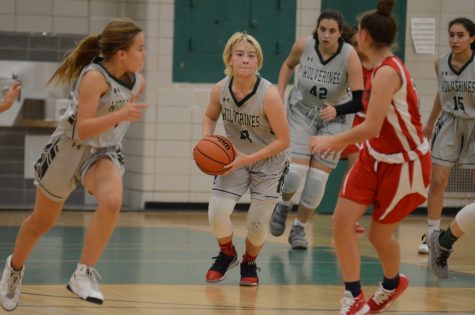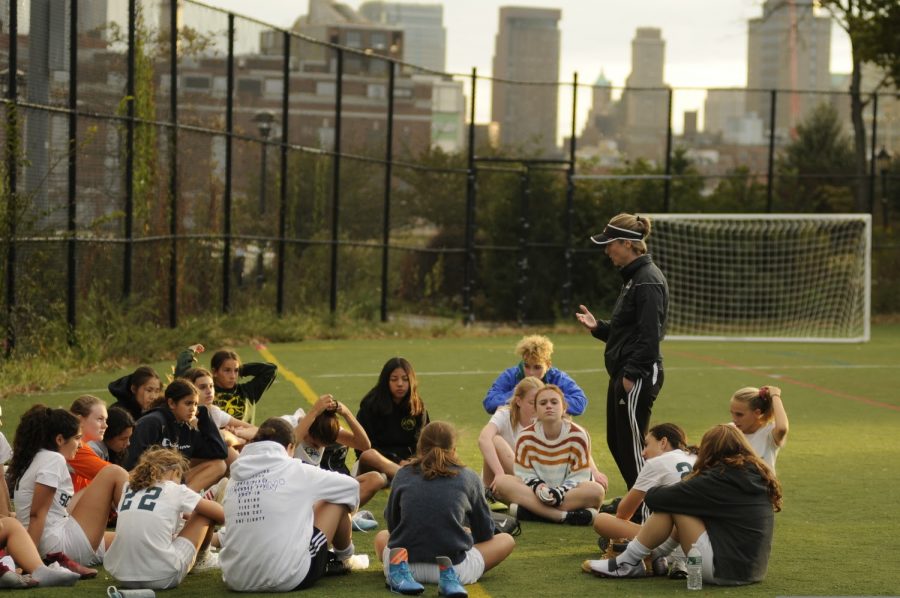Why the Major Sports Comeback Has Begun — During the Coronavirus Pandemic
As the return of American sports gains momentum, leagues move cautiously and learn to live with risk.
Members of the Girls’ Varsity Soccer team sit together on the field during a practice. Huddles and group meetings like these are essential to the game, but with the pandemic, leagues must consider all of the potential ways to limit player contact.
A single positive COVID-19 test of one athlete in one league was all it took to put a stop to the entire world of American sports.
On March 11, 2020, Utah Jazz center Rudy Gobert tested positive for COVID-19, immediately triggering a suspension of the NBA season. Thousands of fans quickly left Chesapeake Energy Arena in confusion after his results were announced right before the Jazz’s tip-off against Oklahoma City Thunder. Gobert’s test inadvertently marked the start of the domino-like cancellation of all major sports events. Just as quickly as the crowd had to leave the seats they had just settled into, the entire nation was torn apart from their beloved sports events. Quickly following the NBA’s lead, the Major League Baseball season was postponed, the NCAA was canceled, the NHL suspended play, and America was hit hard with an unprecedented sports drought.
Sports have always been a constant part of the background noise of American culture. Games are broadcasted live on television; Twitter has its fair share of banter and debates; radios are filled with play-by-play updates by commentators. Sports were always there for us to enjoy, always giving us something to talk about when the conversation slowed.
When news broke of the novel coronavirus outbreak in the NBA, it was decided in everyone’s best interest to put a halt to the streamline of sporting events. Both players and fans were left unsure of what to fill the gaping hole in which sports existed for so long with. No amount of replays of classic games or sports documentaries could substitute watching today’s athletes in action or compare to the rush of a roaring crowd, live in a packed stadium.
However, after months of pessimism and uncertainty surrounding whether major sports would return in 2020, the biggest sports organizations made a flurry of announcements about potential plans to comeback. The NFL is moving forward with opening training facilities, and they released a 2020 schedule with plans to return on September 10, 2020. The MLB is negotiating with players for a shortened season. The NBA is in talks to restart its season in July at Walt Disney World in Florida, which would be a single site for games, housing, and practices. “Being able to see basketball played again would be amazing because so many people wanted to witness the improvements of the league and the teams that have arrived since pre-season last year,” said Ishan Dhar ’21.
For U.S. Open Tennis, the USTA is planning to host the tournament in late August 2020. Moreover, soccer leagues in North America are working towards planning summer tournaments. The English Premier League’s plans to return are underway. Even as possible starts remain in doubt due to health concerns, these organizations persist in finding ways to comeback.
The new increase in available testing and decrease in cases are part of the dramatic changes few could foresee months ago. Testing has allowed some leagues to get further approval for plans to comeback and reassure fans that proper health measures are being taken. The prospect that players, coaches, referees, and other staff can be tested for COVID-19 before games has increased the likelihood of resuming play. The expanding capacity of leagues to test individuals in as close to real-time as possible to ensure they are not infected has been crucial in recent plans for leagues to return.
While none would have been able to pursue reopening plans without the promise of widespread testing, there are several challenges that remain. One obstacle lies in the number of testing kits needed to be made available to cover all staff. According to Major League Baseball, 3,000 kits are needed for players, staff, and broadcasters to get its season going, and multiple rounds of this testing would be necessary to keep the season going after such a return. These large sports organizations would have to fund and administer massive amounts of tests. Secondly, current testing yields results that often take several days. Especially with team-based sports that require direct physical contact and the possibility of asymptomatic individuals, speedy testing is required to boost public health and restore confidence in a comeback.

Coronavirus testing remains a major hurdle in the return of American sports, and leagues will risk public health if the proper steps are not taken. However, if the past months have shown us anything, it is that technology for testing is evolving and that we are seeing improvements in our ability to screen athletes. “As much of a struggle it can be, there is no reason not to take the chance and bring back joy to fans waiting for sports to comeback,” said Dhar.
League officials and team owners are also considering the financial consequences of not returning. A potential loss of billions of dollars across various sports organizations made the fight for a comeback inevitable. Many athletes are just like other workers who want to get back to work and get paid. The ramifications of the NBA season being suspended for LeBron James manifests in the loss of over $400,000 for every game the Los Angeles Lakers do not play. There are also low-paid minor league baseball players who need money for basic necessities.
Many teams require revenue to cover fixed costs. From building stadiums to acquiring athletes, some organizations have borrowed millions of dollars for their teams. This year, the NFL owners lent the Los Angeles Rams $500 million for funding the construction of SoFi stadium, which was scheduled to open this year. The Mets pay millions annually toward construction debt on Citi Field. Moreover, all of the officials and athletes still need to get paid.
While sports may not return in the same way that we have grown to love, we are seeing unimaginable changes that would not have been made possible at the onset of the COVID-19 outbreak. New testing measures and stadiums with varying levels of spectator capacity are underway. League officials and player representatives are all considering the major risks of returning. Organizations are constantly updating the public with new plans and negotiations. Once comebacks are in full swing, avid spectators will have something to cheer for — regardless of whether fans are in the stands or not.
Once comebacks are in full swing, avid spectators will have something to cheer for — regardless of whether fans are in the stands or not.
Karen Phua is a Copy Chief Editor for ‘The Science Survey.’ She enjoys journalistic writing for the connection that it provides with avid readers interested...
Jamie Lee Nicolas is an Editor-in-Chief of the ‘The Science Survey.' Jamie enjoys journalistic writing because it allows her to express her opinions...

